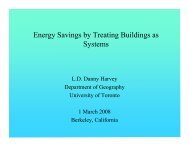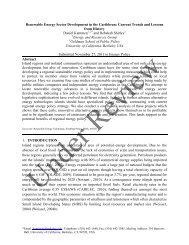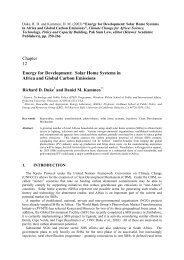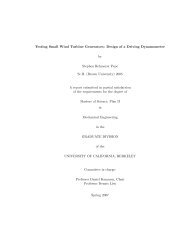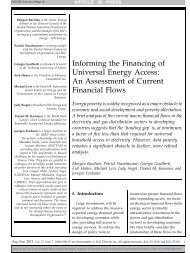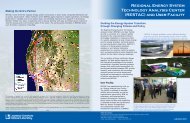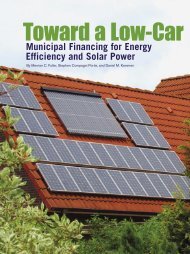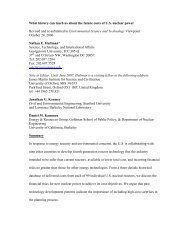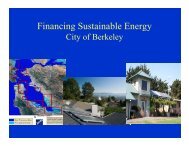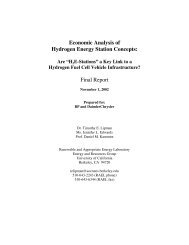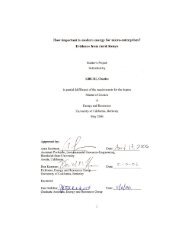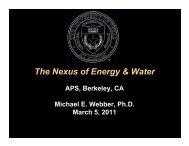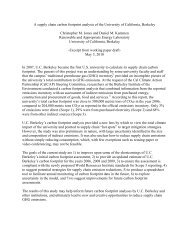Deep carbon reductions in California require electrification and ...
Deep carbon reductions in California require electrification and ...
Deep carbon reductions in California require electrification and ...
You also want an ePaper? Increase the reach of your titles
YUMPU automatically turns print PDFs into web optimized ePapers that Google loves.
Environ. Res. Lett. 8 (2013) 014038a list of over 200 unique efficiency measures whilethe transportation sector adopted fuel efficiency potentialfrom exist<strong>in</strong>g national <strong>and</strong> State studies. Industry technicalpotential estimates were based on CEC reports disaggregatedby <strong>in</strong>dustry sector <strong>and</strong> end-use (process heat<strong>in</strong>g, boiler-basedsystems, motor systems, heat<strong>in</strong>g, ventilation, air-condition<strong>in</strong>g,etc).Electrification projections are based on stock model<strong>in</strong>gfor build<strong>in</strong>g water <strong>and</strong> space heat<strong>in</strong>g <strong>and</strong> for passengervehicles assum<strong>in</strong>g aggressive transition to electricity-basedheat<strong>in</strong>g systems <strong>in</strong> build<strong>in</strong>gs start<strong>in</strong>g <strong>in</strong> 2015 <strong>and</strong> to alternativepassenger vehicles <strong>in</strong> transportation, respectively, with marketpenetration assumptions described <strong>in</strong> the supplementarymaterial (available at stacks.iop.org/ERL/8/014038/mmedia).The <strong>carbon</strong> sav<strong>in</strong>gs potential for energy conservationwas estimated us<strong>in</strong>g a simple adoption rate model of energysav<strong>in</strong>g actions. From a database of historical non-energyactions, long-term adoption rates were estimated for a setof conservation actions <strong>in</strong> home energy usage <strong>and</strong> passengervehicle mile reduction, as well as a number of other measures<strong>in</strong> diet, recycl<strong>in</strong>g, <strong>and</strong> consumption. Carbon sav<strong>in</strong>gs asa function of time were estimated by calculat<strong>in</strong>g <strong>carbon</strong><strong>in</strong>tensities for electricity (CO 2 /kWh) <strong>and</strong> transportation(CO 2 /VMT).Low-GHG electricity model<strong>in</strong>g utilized a high-resolutionvariable renewable resource capacity plann<strong>in</strong>g model(SWITCH) of the <strong>in</strong>terconnected Western North Americangrid. SWITCH used spatially resolved, time-synchronizedhourly solar, w<strong>in</strong>d, <strong>and</strong> dem<strong>and</strong> data to explore future low<strong>carbon</strong> electricity scenarios. Optimizations m<strong>in</strong>imized thecost of power between present day <strong>and</strong> 2050 while subjectto reliability <strong>and</strong> policy constra<strong>in</strong>ts. Carbon emissions wereconstra<strong>in</strong>ed to reach 80% below 1990 levels <strong>in</strong> the year 2050.Biofuel supply estimates were made with all biomassdirected to liquid biofuels <strong>and</strong> resultant biofuel assumed toreplace oil-based liquid fuel. Biomass <strong>and</strong> biofuel availabilityprojections utilized technical potential assumptions for <strong>in</strong>-State biomass supply, biomass supply mix, biofuel yield, <strong>and</strong>life-cycle <strong>carbon</strong> emission associated with biofuel production.Biofuel production was assumed to replace gasol<strong>in</strong>e <strong>in</strong>the transportation sector. Sources for biomass materialsavailability <strong>in</strong>clude earlier reports from Oak Ridge NationalLaboratory, the University of <strong>California</strong>, Berkeley, <strong>and</strong> theUniversity of <strong>California</strong>, Davis.All methods <strong>and</strong> key assumptions are described morefully <strong>in</strong> the supplementary material available onl<strong>in</strong>e at (stacks.iop.org/ERL/8/014038/mmedia) .AcknowledgmentsWe thank the <strong>California</strong> Energy Commission for support. Thispaper reflects the views of the authors <strong>and</strong> does not necessarilyreflect the view of the <strong>California</strong> Energy Commission or theState of <strong>California</strong>. DMK thanks the Class of 1935 of theUniversity of <strong>California</strong>, Berkeley, <strong>and</strong> the Karsten FamilyFoundation.None of the authors have a conflict of <strong>in</strong>terest for thiswork.ReferencesM Wei et al[1] Commission of European Communities 2007 Limit<strong>in</strong>g GlobalClimate Change to 2 Degrees Celsius: The Way Ahead for2020 <strong>and</strong> Beyond (available at http://eur-lex.europa.eu/LexUriServ/site/en/com/2007/com2007 0002en01.pdf,accessed 1 July 12)[2] <strong>California</strong> Institute for Energy <strong>and</strong> Environment 2012<strong>California</strong> Vulnerability <strong>and</strong> Adaption Study (available athttp://uc-ciee.org/climate-change/california-vulnerability<strong>and</strong>-adaptation-study,accessed 1 August 12)[3] Jackson S 2009 Parallel pursuit of near-term <strong>and</strong> long-termclimate mitigation Science 326 526–7[4] <strong>California</strong> Environmental Protection Agency Air ResourcesBoard 2012 <strong>California</strong> Greenhouse Gas Inventory for 1990(available at www.arb.ca.gov/cc/<strong>in</strong>ventory/pubs/reports/appendix a1 <strong>in</strong>ventory ipcc sum 1990.pdf, accessed10 June 12)[5] Williams J H, DeBenedictis A, Ghanadan R, Mahone A,Moore J, Morrow W R III, Price S <strong>and</strong> Torn M S 2012 Thetechnology path to deep greenhouse gas emissions cuts by2050: the pivotal role of electricity Science 335 53–9[6] <strong>California</strong> Council on Science <strong>and</strong> Technology 2011<strong>California</strong>’s Energy Future—The View to 2050 (available athttp://ccst.us/publications/2011/2011energy.pdf, accessed1 July 12)[7] Long J C S 2011 Piecemeal cuts won’t add up to radical<strong>reductions</strong> Nature 478 429[8] European Climate Foundation 2010 ROADMAP 2050: APractical Guide to a Prosperous, Low-GHG Europe(available at www.roadmap2050.eu, accessed 1 July 12)[9] Yang C, Ogden J M, Sperl<strong>in</strong>g D <strong>and</strong> Hwang R 2011<strong>California</strong>’s Energy Future: Transportation Energy Use <strong>in</strong><strong>California</strong> (Sacramento, CA: <strong>California</strong> Council on Science<strong>and</strong> Technology) (available at http://ccst.us/publications/2011/2011transportation.pdf, accessed 1 July 2012)[10] Jacobson M Z <strong>and</strong> Delucchi M A 2011 Provid<strong>in</strong>g all globalenergy with w<strong>in</strong>d, water, <strong>and</strong> solar power, part I:technologies, energy resources, quantities <strong>and</strong> areas of<strong>in</strong>frastructure, <strong>and</strong> materials Energy Policy 39 1154–69[11] Fripp M 2008 Optimal <strong>in</strong>vestment <strong>in</strong> w<strong>in</strong>d <strong>and</strong> solar power <strong>in</strong><strong>California</strong> PhD Dissertation University of <strong>California</strong>Energy <strong>and</strong> Resources Group[12] Nelson J, Johnston J, Mileva A, Matthias Fripp M, Hoffman I,Petros-Good A, Blanco C <strong>and</strong> Kammen D M 2012High-resolution model<strong>in</strong>g of the western North Americanpower system demonstrates low-cost <strong>and</strong> low-GHG futuresEnergy Policy 43 436–47[13] Fripp M 2012 SWITCH: a plann<strong>in</strong>g tool for power systemswith large shares of <strong>in</strong>termittent renewable energy Environ.Sci. Technol. 46 6371–8[14] State of <strong>California</strong> 2013 ZEV Action Plan A Roadmap Toward1.5 Million Zero-Emission Vehicles on <strong>California</strong>Roadways by 2025 First Edition (Governor’s InteragencyWork<strong>in</strong>g Group on Zero-Emission Vehicles, Office ofGovernor Edmund G Brown Jr) (available at http://opr.ca.gov/docs/Governor’s Office ZEV Action Plan (02-13).pdf, accessed 19 February 13)[15] Schmidt P S 1984 Electricity <strong>and</strong> Industrial Productivity, ATechnical <strong>and</strong> Economic Perspective (New York, NY:Pergamon)[16] Electric Power Research Institute 2009 The Potential toReduce CO 2 Emissions by Exp<strong>and</strong><strong>in</strong>g End-UseApplications of Electricity EPRI Report 1018871[17] US Department of Energy 2007 Improv<strong>in</strong>g Process Heat<strong>in</strong>gSystem Performance: A Sourcebook for Industry 2nd edn(Golden, CO: US Department of Energy IndustrialTechnologies Program <strong>and</strong> Industrial Heat<strong>in</strong>g EquipmentAssociation)9



